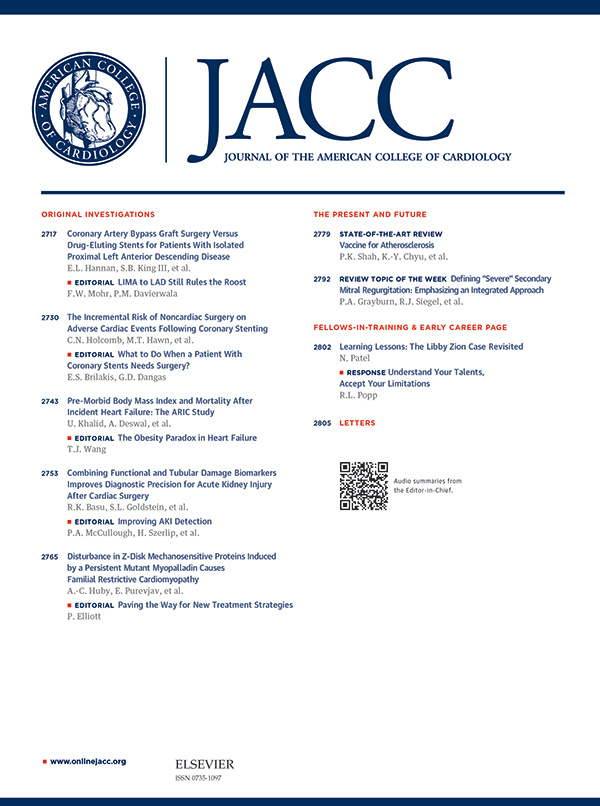Early Increase in Serum Transthyretin by Acoramidis Independently Predicts Improved Survival in TTR Amyloid Cardiomyopathy
IF 21.7
1区 医学
Q1 CARDIAC & CARDIOVASCULAR SYSTEMS
引用次数: 0
Abstract
Background
Acoramidis is a novel, high-affinity stabilizer that achieves ≥90% transthyretin (TTR) stabilization. The phase 3 study, ATTRibute-CM (Efficacy and Safety of AG10 in Subjects With Transthyretin Amyloid Cardiomyopathy), met its primary hierarchical efficacy endpoint with mortality, morbidity, and functional components at 30 months. Stabilization of TTR (prealbumin) by acoramidis results in an immediate and sustained rise in serum transthyretin (sTTR) levels, but the association between this pharmacodynamic effect and all-cause mortality (ACM) has not been elucidated.
Objectives
The purpose of this study was to assess the prognostic implication of acoramidis-mediated early change in sTTR and its relationship to ACM.
Methods
We evaluated sTTR levels in 557 participants with ATTR-CM from the ATTRibute-CM study population. For the Kaplan-Meier overall survival assessment, univariate and multivariate modeling were used to evaluate factors associated with ACM. Modeling and simulation analyses described acoramidis population pharmacokinetics.
Results
Treatment with acoramidis resulted in a sharp and significant early rise in sTTR levels (mean 9.1 mg/dL) within 28 days which was sustained throughout the 30-month treatment period. Participants with ≥20 mg/dL sTTR at baseline had significantly (P < 0.0001) greater overall survival probability than those with <20 mg/dL. An early increase in sTTR levels on day 28 of dosing (early ΔTTR) was associated with reduced ACM in univariate analysis (HR: 0.96 per 1 mg/dL increase in early ΔTTR; 95% CI: 0.93-0.98; P = 0.002). In the multivariate analysis, after adjusting for TTR variant status, baseline New York Heart Association functional class, baseline National Amyloidosis Centre stage, and baseline sTTR level, early ΔTTR remained independently associated with reduced ACM (P < 0.001). Bootstrap mediation analyses showed that early ΔTTR fully mediates the effect of acoramidis treatment on ACM probability (average causal mediation effect = −0.117; P = 0.002; average direct effect = 0.0366; P = 0.448). Logistic modeling demonstrated that among participants treated with acoramidis, early ΔTTR was associated with reduced ACM, whereas no such association was observed in participants treated with placebo. For every 5 mg/dL increase in sTTR levels, a logistic model predicted a 31.6% relative reduction in odds of ACM.
Conclusions
Acoramidis-mediated early ΔTTR is independently associated with improved survival after adjusting for known predictors. This provides strong evidence for a direct association between a prompt and sustained increase in sTTR upon initiation of treatment with acoramidis and survival. Early changes in sTTR could be used as a marker of the degree of TTR stabilization. (Efficacy and Safety of AG10 in Subjects With Transthyretin Amyloid Cardiomyopathy [ATTRibute-CM]; NCT03860935)

Acoramidis早期提高血清转甲状腺素可独立预测TTR淀粉样心肌病患者生存率的提高
acoramidis是一种新型的高亲和力稳定剂,可实现≥90%的甲状腺转甲状腺素(TTR)稳定。这项名为ATTRibute-CM (AG10在转甲状腺蛋白淀粉样心肌病患者中的疗效和安全性)的3期研究在30个月时达到了其主要分级疗效终点,包括死亡率、发病率和功能成分。acoramidis稳定TTR(前白蛋白)可导致血清转甲状腺素(sTTR)水平立即持续升高,但这种药效学效应与全因死亡率(ACM)之间的关系尚未阐明。目的本研究的目的是评估acoramidis介导的sTTR早期改变的预后意义及其与ACM的关系。方法:我们评估了来自ATTRibute-CM研究人群的557例atr - cm患者的sTTR水平。对于Kaplan-Meier总生存评估,采用单因素和多因素建模来评估与ACM相关的因素。建模和仿真分析描述了菖蒲的群体药代动力学。结果acoramidis治疗可导致sTTR水平在28天内急剧升高(平均9.1 mg/dL),并在30个月的治疗期间持续升高。基线时sTTR≥20mg /dL的受试者具有显著的(P <;0.0001)总生存率高于20 mg/dL。单因素分析显示,给药第28天sTTR水平早期升高(ΔTTR早期)与ACM降低相关(早期每1 mg/dL升高0.96 ΔTTR;95% ci: 0.93-0.98;P = 0.002)。在多变量分析中,在调整了TTR变异状态、基线纽约心脏协会功能分级、基线国家淀粉样变性中心分期和基线sTTR水平后,早期ΔTTR仍然与降低的ACM独立相关(P <;0.001)。Bootstrap中介分析显示,早期ΔTTR完全中介了acoramidis治疗对ACM概率的影响(平均因果中介效应=−0.117;P = 0.002;平均直接效应= 0.0366;P = 0.448)。Logistic模型表明,在接受acoramidis治疗的参与者中,早期ΔTTR与降低的ACM相关,而在接受安慰剂治疗的参与者中没有观察到这种关联。sTTR水平每增加5 mg/dL,逻辑模型预测ACM的几率相对降低31.6%。结论:调整已知预测因子后,sacoramidis介导的早期ΔTTR与生存率的提高独立相关。这为开始使用acoramidis治疗后sTTR的迅速和持续增加与生存之间的直接关联提供了强有力的证据。早期str的变化可以作为TTR稳定程度的标志。AG10治疗转甲状腺素淀粉样心肌病的疗效和安全性[属性- cm];NCT03860935)
本文章由计算机程序翻译,如有差异,请以英文原文为准。
求助全文
约1分钟内获得全文
求助全文
来源期刊
CiteScore
42.70
自引率
3.30%
发文量
5097
审稿时长
2-4 weeks
期刊介绍:
The Journal of the American College of Cardiology (JACC) publishes peer-reviewed articles highlighting all aspects of cardiovascular disease, including original clinical studies, experimental investigations with clear clinical relevance, state-of-the-art papers and viewpoints.
Content Profile:
-Original Investigations
-JACC State-of-the-Art Reviews
-JACC Review Topics of the Week
-Guidelines & Clinical Documents
-JACC Guideline Comparisons
-JACC Scientific Expert Panels
-Cardiovascular Medicine & Society
-Editorial Comments (accompanying every Original Investigation)
-Research Letters
-Fellows-in-Training/Early Career Professional Pages
-Editor’s Pages from the Editor-in-Chief or other invited thought leaders

 求助内容:
求助内容: 应助结果提醒方式:
应助结果提醒方式:


